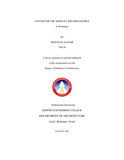Please use this identifier to cite or link to this item:
https://elibrary.khec.edu.np:8080/handle/123456789/630| Title: | CENTER FOR THE MOBILITY IMPAIRED PEOPLE |
| Authors: | MONALISA KAPAIR 740120 |
| Advisor: | Ar. Sujeet Rai |
| Issue Date: | Aug-2023 |
| College Name: | Khwopa Engineering College |
| Level: | Bachelor's Degree |
| Degree: | BE Architecture |
| Department Name: | Department of Architecture |
| Abstract: | Building and its built environment have always been a part of human civilization, from the very beginning. Wherever and whenever we establish a settlement. we will build all the structures that will create a built environment, which is needed for the society to function properly. Through time, this built environment has become part of the larger ecosystem, which not only reflects the culture, and identity of the people living in it but in some way the built environment affecting their lifestyle. Looking at the current built environment that is shaping our cityscape today, a structure that was built as a block without taking into consideration the humanistic value that shapes the psychological and physiological aspect of the human being. There is a distinct effect on mental health resulting from certain physical factors (pollution. poor waste management and road traffic) regardless of psychosocial and socio demographic components of the neighborhood that are perceived to be positive. The existing centers for differently abled persons in Nepal today mostly do not meet the expectation and requirement as they were designed without any precedence study and research. Only very few numbers of such centers were designed considering the requirements of such people but the capacity is very limited. Similarly, several research has been conducted worldwide to investigate and to prove the effectiveness of the healing architecture through the implementation of therapeutic design approach. but mostly none of the research are focusing on the implementation of the design approach for the mobility-impaired community. This research aims to determine the effects of the therapeutic design approach towards the mobility impaired community by analyzing which design approach are the most suitable and befitting to be used in the context of the study area i.e. Kathmandu valley. This research also aims to construct a theoretical design framework that will help to design a therapy facility and vocational facility for the mobility impaired community using the implementation of therapeutic design approach. The data were collected through analyzing literature such as Journals, articles and books that were utilized with the combination of the synthetization of case study. From all the data that has been collected and in comparison towards the case study, a working and functional design framework were able to be constructed. The result indicates that the effect of the therapeutic design approach was able to be manipulated into the design. So that it can be used to improve the health of building occupants. This thesis project titles the "CENTRE FOR THE MOBILITY IMPAIRED PEOPLE". It target the low economical background people who bear short and long term of lack of mobility. These groups of people are the people from our community who somehow lost the efficiency of mobility due to various reasons. As the title suggests, this center provides the facilities i.e., medical therapies as well as the income generating trainings which is vocational trainings to make them psychologically and economically independent. |
| URI: | https://elibrary.khec.edu.np/handle/123456789/630 |
| Appears in Collections: | Architecture 2074 Batch Thesis |
Files in This Item:
| File | Description | Size | Format | |
|---|---|---|---|---|
| 740120_Monalisa_Center for Mobility impaired people.pdf Restricted Access | 14.98 MB | Adobe PDF |  View/Open Request a copy |
Items in DSpace are protected by copyright, with all rights reserved, unless otherwise indicated.
